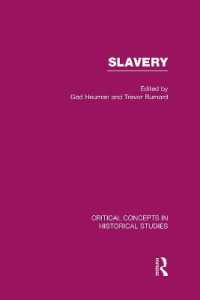Full Description
Oil Spill Environmental Forensics provides a complete view of the various forensic techniques used to identify the source of an oil spill into the environment. The forensic procedures described within represent various methods from scientists throughout the world. The authors explore which analytical and interpretative techniques are best suited for a particular oil spill project.
This handy reference also explores the use of these techniques in actual environmental oil spills. Famous incidents discussed include the Exxon Valdez incident in 1989 and the Guanabara Bay, Brazil 2000. The authors chronicle both the successes and failures of the techniques used for each of these events.
Dr. Zhendi Wang is a senior research scientist and Head of Oil Spill Research of Environment Canada, working in the oil and toxic chemical spill research field. He has authored over 270 academic publications and won a number of national and international scientific honors and awards. Dr. Wang is a member of American Chemical Society (ACS), the Canadian Society for Chemistry (CSC), and the International Society of Environmental Forensics (ISEF).
Contents
FOREWORD; CONTRIBUTORS; Chemical Fingerprinting of Spilled or Discharged Petroleum - Methods and Factors Affecting Petroleum Fingerprints in the Environment; Spill Site Investigation in Environmental Forensic Investigation; Petroleum Biomarker Fingerprinting for Oil Spill Characterization and Source Identification; Characterization of Polycyclic Aromatic Sulfur Heterocycles for Source Identification; Oil Spill Identification by Comprehensive Two-Dimensional Gas Chromatography (GCxGC); Application of Stable Isotope Ratios in Spilled Oil Identification; Emerging CEN Methodology for Oil Spill Identification; Advantages of Quantitative Chemical Fingerprinting in Oil Spill Identification; A Multivariate Approach to Oil Hydrocarbon Fingerprinting and Spill Source Identification; Chemical Heterogeneity of Marine Heavy Fuel Oils; Biodegradation of Oil Hydrocarbons and Its Implications for Source Identification; Identification of Hydrocarbons in Biological Samples for Source Determination; Trajectory Modeling of Marine Oil Spills; Oil Spill Remote Sensing : A Forensics Approach; Advances in Forensic Techniques for Petroleum Hydrocarbons: The Exxon Valdez Experience; Case Study: Oil Spills in the Straits of Malacca, Malaysia; Evaluation of Hydrocarbon Sources in Guanabara Bay, Brazil







